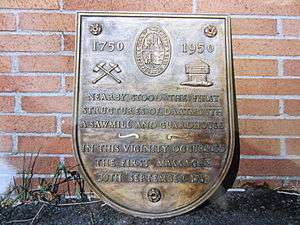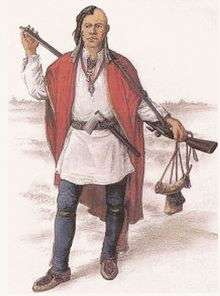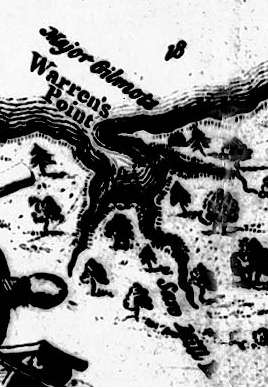Raid on Dartmouth (1749)
The Raid on Dartmouth (1749) occurred during Father Le Loutre's War on September 30, 1749 when a Mi'kmaq militia from Chignecto raided Major Ezekiel Gilman's sawmill at present-day Dartmouth, Nova Scotia, killing four workers and wounding two. This raid was one of seven the Wabanaki Confederacy and Acadians would conduct against the settlement during the war.
| Raid on Dartmouth (1749) | |||||||
|---|---|---|---|---|---|---|---|
| Part of Father Le Loutre's War | |||||||
 Plaque to Raid on Dartmouth (1749) and the blockhouse that was built in response (1750), Dartmouth Heritage Museum | |||||||
| |||||||
| Belligerents | |||||||
|
Mi'kmaq militia Acadian militia |
| ||||||
| Commanders and leaders | |||||||
| Major Ezekiel Gilman[1] | |||||||
| Strength | |||||||
| 40 Mi'kmaq | 6 British | ||||||
| Casualties and losses | |||||||
| 3 killed | 4 killed, 2 wounded | ||||||
| Military history of Miꞌkmaq people | ||||||||||||||||||||||||||||||||||||||||||||||||||||||||||||||||
|---|---|---|---|---|---|---|---|---|---|---|---|---|---|---|---|---|---|---|---|---|---|---|---|---|---|---|---|---|---|---|---|---|---|---|---|---|---|---|---|---|---|---|---|---|---|---|---|---|---|---|---|---|---|---|---|---|---|---|---|---|---|---|---|---|
 Miꞌkmaq warrior | ||||||||||||||||||||||||||||||||||||||||||||||||||||||||||||||||
| Events | ||||||||||||||||||||||||||||||||||||||||||||||||||||||||||||||||
|
||||||||||||||||||||||||||||||||||||||||||||||||||||||||||||||||
| Other | ||||||||||||||||||||||||||||||||||||||||||||||||||||||||||||||||
| ||||||||||||||||||||||||||||||||||||||||||||||||||||||||||||||||
Historical context
Despite the British Conquest of Acadia in 1710, Nova Scotia remained primarily occupied by Catholic Acadians and Mi'kmaq. Father Le Loutre's War began when Edward Cornwallis arrived to establish Halifax with 13 transports on June 21, 1749.[2]
By the time Cornwallis had arrived in Halifax, there was a long history of the Wabanaki Confederacy (which included the Mi'kmaq) killing British civilians along the New England/ Acadia border in Maine (See the Northeast Coast Campaigns 1688, 1703, 1723, 1724, 1745, 1746, 1747).[3][4]
After establishing an initial settlement in Halifax in the summer of 1749, it was imperative that Governor Edward Cornwallis make peace with the Native peoples of the province before further colonization could proceed. On 15 August, Governor Cornwallis and members of his Council met with representatives of the Penobscott, Naridgwalk, St. John, Cape Sable and other tribes aboard HMS Beaufort in Halifax Harbour. They agreed to sign a redrafted treaty of 1725 that would be ratified at a later date.[5]
Governor Cornwallis was informed in August that two vessels were attacked by the Indians at Canso whereby "three English and seven Indians were killed." Council believed the attack had been orchestrated by an Abbe Le Loutre.[6]
Prior to this incident, the priest had written the following to the minister of marine in France: "As we cannot openly expose the English ventures, I think that we cannot do better than to incite the indians to continue warring on the English; my plan is to persuade the Indians to send word to the English that they will not permit new settlements to be made in Acadia. . . I shall do my best to make it look to the English as if this plan comes from the Indians and that I have no part in it."[7]
To guard against Mi'kmaq, Acadian and French attacks on the new Protestant settlements, British fortifications were erected in Halifax (1749), Bedford (Fort Sackville) (1749), Dartmouth (1750), Lunenburg (1753) and Lawrencetown (1754).
On 24 September 1749, the Mi'kmaq formally wrote to Governor Cornwallis through Father Maillard, proclaiming their ownership of the land, and expressing their opposition to the British actions in settling at Halifax. Some historians have read this letter as declaration of hostility against the British.[8] Other historians have questioned that interpretation.[9]
Raids started at Canso, then Chignecto and then at present-day Dartmouth. During Father Le Loutre's War, there were four raids on Dartmouth.[10]
Major Ezekiel Gilman (Gillman) was in command of the mill at Dartmouth. He had worked in the lumber industry in Exeter, New Hampshire. He had distinguished himself in Colonel Samuel Moore's Regiment at the Siege of Louisbourg (1745), where he engineered moving the British canons across boggy terrain.[11][12][13] Sir William Pepperrell referred to Gilman as "very serviceable" in the expedition.[14] (He returned various times to New Hampshire but died in Nova Scotia in 1755.)[15][16][17][18][19][20][21][22]
Raid
On September 30, 1749, about forty Mi'kmaq attacked six men who were in Dartmouth cutting trees. The Mi'kmaq killed four of them on the spot, took one prisoner and one escaped.[23] Two of the men were scalped and the heads of the others were cut off. The attack was on the saw mill at Dartmouth Cove (Mill Location ), which was under the command of Major Ezekiel Gilman. A detachment of rangers was sent after the raiding party and cut off the heads of two Mi'kmaq and scalped one.[6]
Consequence

On October 2, 1749, to stop the attacks on the emigrants, Governor Edward Cornwallis created an extirpation proclamation directing "all Officers Civil and Military, and all His Majesty's Subjects or others to annoy, distress, take or destroy the Savage commonly called Micmac, wherever they are found." [24] As part of the proclamation he offered a bounty for the capture or scalps of Mi'kmaw men and for the capture of women and children: "every Indian you shall destroy (upon producing his Scalp as the Custom is) or every Indian taken, Man, Woman or Child."[25]
Prior to Cornwallis, there was a long history of Massachusetts Governors issuing bounties for taking prisoner or killing Indians in an attempt to thwart Indian raids on British settlers in Northern New England.[3][26] Cornwallis followed New England's example. He set the amount at the same rate that the Mi'kmaq received from the French for British scalps.[27][28] To carry out this task, Cornwallis raised two companies of rangers, one led by Major Gilman and the other by Captain William Clapham.[29] These two companies served alongside that of John Gorham's company. The three companies scoured the land around Halifax looking for Mi'kmaq, however, the Rangers never made contact with any Mi'kmaq.[27]
Cornwallis also stationed thirty men guarding the saw mill over the following winter, with two armed vessels. Gilman left unannounced to New England by April 1750.[30][29] By July, Cornwallis had given the saw mill to Clapham to manage.[29] In September, he gave command of Gilman's rangers to Captain Francis Bartelo.[29]
Despite Cornwallis' efforts to defend the community, in July 1750, the Mi'kmaq killed and scalped seven men who were at work in Dartmouth.[31] In August 1750, 353 people arrived on the ship Alderney and began the town of Dartmouth, which was laid out in the autumn of that year.[31] The following month, on September 30, 1750, Dartmouth was attacked again by the Mi'kmaq and five more residents were killed.[32] In October 1750 a group of about eight men went out "to take their diversion; and as they were fowling, they were attacked by the Indians, who took the whole prisoners; scalped ... [one] with a large knife, which they wear for that purpose, and threw him into the sea ..."[33]
In March 1751, the Mi'kmaq attacked on two more occasions, bringing the total number of raids to six in the previous two years.[34] Three months later, on May 13, 1751, Broussard led sixty Mi'kmaq and Acadians to attack Dartmouth again, in what would be known as the "Dartmouth Massacre".[35]
Controversy
Mi'kmaw historian Daniel N. Paul does not trust the British account of this raid. He dismisses the possibility that Mi'kmaq people would attack unarmed civilians and speculates, instead, that the woodcutters were probably armed better than the Mi'kmaq. Paul provides no historical evidence to support his speculations.[36] He also affirms the right of the Mi'kmaq to use military action to defend their land. In his book We Were Not the Savages Paul writes,:
The question this poses is, why was this group of 'defenseless' Englishmen sent out into the forest alone to cut wood during a time of war without troop protection and thus left vulnerable to attack? If this was the case then it smacks of gross incompetence on a British officer's part. If the story is true and not propaganda, a more credible reason for them being sent out without troop protection is that they were not defenseless but as well-armed as the Mi'kmaq and probably more so. This can be reasonably assumed because, as woodcutters, they had axes to cut wood with, which alone would have made them possessors of weapons as lethally effective, and probably more reliable, than most of the arms the Mi'kmaq had access to. In any event, because the English were assaulting the Mi'kmaq and stealing their territory, Cornwallis and his Council should not have been so affronted and reacted so barbarously when the Mi'kmaq fought back. In fighting back to preserve their freedom and country, the Mi'kmaq paid a heavy price.
— Daniel N. Paul, We Were Not the Savages[36]
Paul asserts that Cornwallis used "a few incidents such as these" to justify his bounty proclamation.[37] Cornwallis' decision to put a bounty on the Mi'kmaq did not pivot simply on the Raid on Dartmouth in 1749.[4] By the time Cornwallis had arrived in Halifax, there was a long history of conflict between the Wabanaki Confederacy (which included the Mi'kmaq) and the British, with British settlement on Wabanaki lands resulting in Wabanaki attacks on civilians along the New England/ Acadia border in Maine (See the Northeast Coast Campaigns 1688, 1703, 1723, 1724, 1745).[4] The proclamation was modelled on earlier proclamations used by New England Governors.
See also
References
- Footnotes
- Salusbury (2011), pp. 164–165.
- Grenier (2008); Akins (1895), p. 7
- Scott, Tod (2016). "Mi'kmaw Armed Resistance to British Expansion in Northern New England (1676–1761)". Journal of the Royal Nova Scotia Historical Society. 19: 1–18.
- Reid & Baker (2008); Grenier (2008)
- http://www.halifaxexplosion.net/dialogue.pdf; http://www.halifaxexplosion.net/1749treaty.pdf
- Akins (1895), p. 18.
- Patterson, Stephen E. (1994). "1744–1763: Colonial Wars and Aboriginal Peoples". In Phillip Buckner; John G. Reid (eds.). The Atlantic Region to Confederation: A History. University of Toronto Press. p. 129. ISBN 978-1-4875-1676-5.
- Griffith, p. 390
- Zemel, Joel (2016). "A Mi'kmaq Declaration of War?". http://www.halifaxexplosion.net. Archived from the original on 2016-10-28. Retrieved August 17, 2017. External link in
|website=(help) - Wilson (1751); Also see http://www.blupete.com/Hist/NovaScotiaBk1/Part5/Ch07.htm
- p. 69
- https://archive.org/details/lifeofsirwilliam00parsrich/page/348?q=%22major+Gilman%22+louisburg
- p. 21
- p. 200
- Major Gilman dies in Halifax in 1755
- Major Gilman moves from New Market Road, Exeter to Gilmanton, New Hampshire
- Major Gilman from Exeter at Louisbourg
- p. 108 Louisbourg
- Fights with distinction at Louisbourg
- False claim that dies at Louisbourg, 1746
- Murdoch (1866); Salusbury (2011)
- Read a memorial of Ezekiel Gilman, together with a state of his case, setting forth his having been appointed captain of a company in the regiment raised in New Hampshire for the intended expedition against Canada, but that when the expedition was at an end his name was left out of the pay rolls and his company given to one of Governor Wentworth's sons.
- Chapman (2000), p. 23; Grenier (2008), p. 150; For the primary sources that document the Raids on Dartmouth see Salusbury (2011); Also see Wilson (1751); Also see http://www.blupete.com/Hist/NovaScotiaBk1/Part5/Ch07.htm
- "British Genocide - Scalp Proclamations 1749". www.danielnpaul.com.
- Olive Dickason, "LOUISBOURG AND THE INDIANS: A STUDY IN IMPERIAL RACE RELATIONS, 1713-1760", University of Ottawa, 1971, at p. 138, referencing Cornwallis' instructions to Capt. Silvanus Cobb, commanding the sloop York, 13 January 1750
- A particular history of the five years French and Indian War in New England ... By Samuel Gardner Drake, William Shirley. p. 134
- Akins (1895), p. 19.
- While the French military hired the Mi'kmaq to gather British scalps, the British military hired rangers to gather Mi'kmaq scalps. The British regulars were not skilled at frontier warfare, while the French Canadiens, Mi'kmaq and Rangers were. British officers Cornwallis, Winslow, and Amherst expressed dismay over the tactics of the rangers and the Mi'kmaq (See Grenier (2008), p. 152; Faragher, p. 405;, Hand, p.99).
- "Selections from the public documents of the province of Nova Scotia". Halifax, N.S., C. Annand. July 5, 1869 – via Internet Archive.
- Gilman seems to have returned having purchased at auction the mill again in 1752.
- Akins (1895), p. 27.
- Grenier (2008), p. 159.
- Wilson (1751) as cited by Grenier (2008), pp. 173-174
- For the two raids that happened in March 1751 see Grenier (2008), p. 160
- Akins (1895), pp. 27-28.
- Paul, Daniel N. (2000). We Were Not the Savages: A Mi'kmaq Perspective on the Collision Between European and Native American Civilizations (2nd ed.). Fernwood. pp. 111-112. ISBN 978-1-55266-039-3.
- Paul, Daniel N. (2000). We Were Not the Savages: A Mi'kmaq Perspective on the Collision Between European and Native American Civilizations (2nd ed.). Fernwood. p. 111. ISBN 978-1-55266-039-3.
- Primary Sources
- London Magazine. v.18 1749. p. 574
- A summary, historical and political, of the first planting, progressive ...By William Douglass, 1755, p. 7
- Salusbury, John (2011). Ronald Rompkey (ed.). Expeditions of Honour: The Journal of John Salusbury in Halifax, Nova Scotia, 1749-53. McGill-Queen's University Press. ISBN 978-0-7735-9089-2.CS1 maint: ref=harv (link)
- Wilson, John (1751). A Genuine Narrative of the Transactions in Nova Scotia since the Settlement, June 1749, till August the 5th, 1751: in which the Nature, Soil, and Produce of the Country are Related, with the Particular Attempts of the Indians to Disturb the Colony. London: A. Henderson et al.CS1 maint: ref=harv (link)
- Secondary Sources
- Akins, Thomas (1895). History of Halifax City. Halifax: Nova Scotia Historical Society.CS1 maint: ref=harv (link) – online at History of Halifax City at Project Gutenberg
- Chapman, Harry (2000). In the Wake of the Alderney: Dartmouth, Nova Scotia, 1750-2000. Dartmouth Historical Association. ISBN 978-1-55109-374-1.CS1 maint: ref=harv (link)
- Grenier, John (2008). The Far Reaches of Empire: War in Nova Scotia, 1710-1760. University of Oklahoma Press. ISBN 978-0-8061-3876-3.CS1 maint: ref=harv (link)
- Murdoch, Beamish (1866). A History of Nova-Scotia, Or Acadie. Vol. II. Halifax: J. Barnes. p. 162.
- Reid, John G.; Baker, Emerson W. (2008). "Amerindian Power in the Early Modern Northeast: A Reappraisal". Essays on Northeastern North America, Seventeenth and Eighteenth Centuries. University of Toronto Press. pp. 129–152. doi:10.3138/9781442688032. ISBN 978-0-8020-9137-6. JSTOR 10.3138/9781442688032.12.CS1 maint: ref=harv (link)
- Mrs. William Lawson. The History of The Townships of Dartmouth, Preston and Lawrencetown, Halifax County, Nova Scotia, pp. 4-5
- Landry, Peter. The Lion & The Lily. Vol. 1, Trafford Publishing, Victoria, B.C., 2007.
- John Faragher. Great and Nobel Scheme. Norton. 2005.